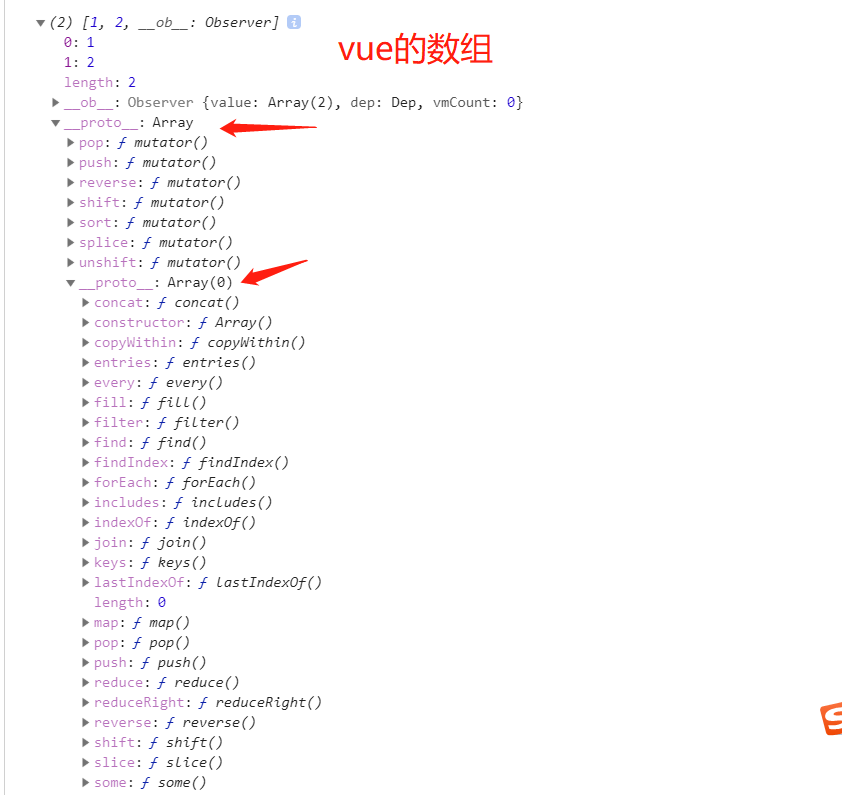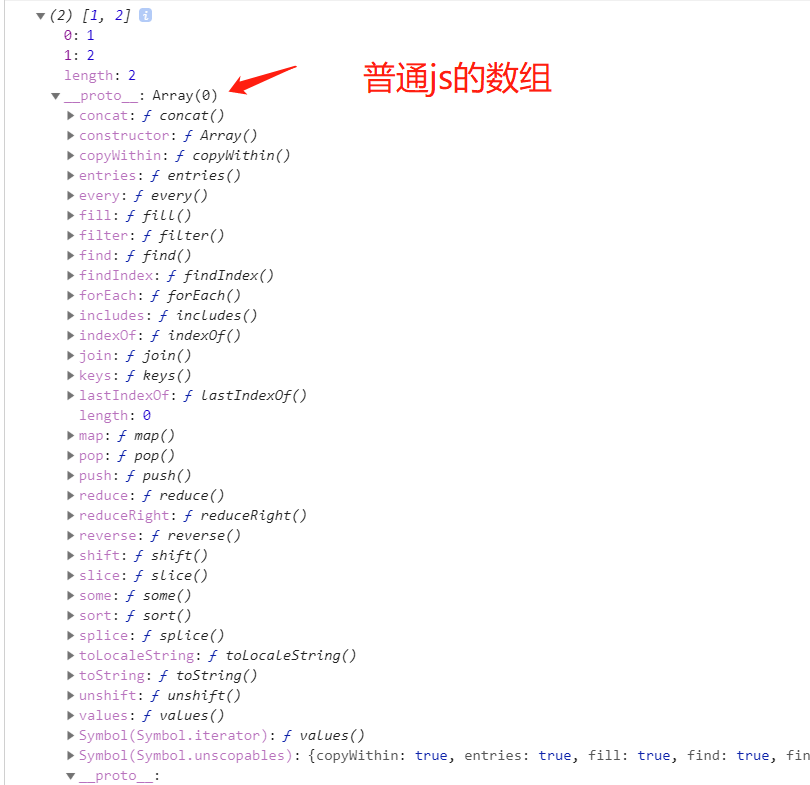# Vue.set 实现原理
# 用法
向响应式对象中添加一个 property,并确保这个新 property 同样是响应式的,且触发视图更新。它主要用于向响应式对象上添加新 property,因为 Vue 无法探测普通的新增 property (比如 this.myObject.newProperty = 'hi')
注意1:对象不能是 Vue 实例,或者 Vue 实例的根数据对象。
注意2:对象也可以是已有的响应式属性或普通对象。
参考:
Vue.set API (opens new window)
深入响应式原理 (opens new window)
# 源码分析
Vue.set 和 vm.$set 实现方式一致,这里讲 vm.$set。
vm.$set() 在 new Vue() 时候就被注入到Vue的原型上。
源码位置: vue/src/core/instance/index.js
// Vue 入口文件
import { initMixin } from './init'
import { stateMixin } from './state'
import { renderMixin } from './render'
import { eventsMixin } from './events'
import { lifecycleMixin } from './lifecycle'
import { warn } from '../util/index'
function Vue (options) {
if (process.env.NODE_ENV !== 'production' &&
!(this instanceof Vue)
) {
warn('Vue is a constructor and should be called with the `new` keyword')
}
this._init(options)
}
initMixin(Vue)
// 给Vue原型绑定代理属性:$props, $data
// 给Vue原型绑定三个实例方法: vm.$watch,vm.$set,vm.$delete
stateMixin(Vue)
// 给Vue原型绑定事件相关的实例方法: vm.$on, vm.$once ,vm.$off , vm.$emit
eventsMixin(Vue)
// 给Vue原型绑定生命周期相关的实例方法: vm.$forceUpdate, vm.destroy, 以及私有方法_update
lifecycleMixin(Vue)
// 给Vue原型绑定生命周期相关的实例方法: vm.$nextTick, 以及私有方法_render, 以及一堆工具方法
renderMixin(Vue)
export default Vue
stateMixin()
...
Vue.prototype.$set = set
Vue.prototype.$delete = del
...
set()
源码位置: vue/src/core/observer/index.js
export function set (target: Array<any> | Object, key: any, val: any): any {
// 如果 set 函数的第一个参数是 undefined 或 null 或者是原始类型值,那么在非生产环境下会打印警告信息
// 这个api本来就是给对象与数组使用的
if (process.env.NODE_ENV !== 'production' &&
(isUndef(target) || isPrimitive(target))
) {
warn(`Cannot set reactive property on undefined, null, or primitive value: ${(target: any)}`)
}
if (Array.isArray(target) && isValidArrayIndex(key)) {
// 类似$vm.set(vm.$data.arr, 0, 3)
// 修改数组的长度, 避免索引>数组长度导致splcie()执行有误
target.length = Math.max(target.length, key)
// 利用数组的splice变异方法触发响应式, 这个前面讲过
target.splice(key, 1, val)
return val
}
// target为对象, key在target或者target.prototype上。
// 同时必须不能在 Object.prototype 上
// 直接修改即可, 有兴趣可以看issue: https://github.com/vuejs/vue/issues/6845
if (key in target && !(key in Object.prototype)) {
target[key] = val
return val
}
// 以上都不成立, 即开始给target创建一个全新的属性
// 获取Observer实例
const ob = (target: any).__ob__
// Vue 实例对象拥有 _isVue 属性, 即不允许给Vue 实例对象添加属性
// 也不允许Vue.set/$set 函数为根数据对象(vm.$data)添加属性
if (target._isVue || (ob && ob.vmCount)) {
process.env.NODE_ENV !== 'production' && warn(
'Avoid adding reactive properties to a Vue instance or its root $data ' +
'at runtime - declare it upfront in the data option.'
)
return val
}
// target本身就不是响应式数据, 直接赋值
if (!ob) {
target[key] = val
return val
}
// 进行响应式处理
defineReactive(ob.value, key, val)
ob.dep.notify()
return val
}
接下来分析set()函数:
if (process.env.NODE_ENV !== 'production' &&
(isUndef(target) || isPrimitive(target))
) {
warn(`Cannot set reactive property on undefined, null, or primitive value: ${(target: any)}`)
}
isUndef是判断target是不是等于undefined或者null。isPrimitive是判断target的数据类型是不是string、number、symbol、boolean中的一种。这里判断的目的是:如果当前环境不是生产环境,并且 isUndef(target) || isPrimitive(target) 为真,那么就抛出错误警告。
# 数组的实现
if (Array.isArray(target) && isValidArrayIndex(key)) {
target.length = Math.max(target.length, key)
target.splice(key, 1, val)
return val
}
这里实际就是修改数组时调用 set 方法,然后让我们能够触发响应部分的代码。不过在分析这段代码之前我们来看看vue中数组改变是如何触发视图更新的。下图分别是vue中的数组和普通的js数组:

 源码位置:
源码位置:
import { def } from '../util/index'
const arrayProto = Array.prototype
export const arrayMethods = Object.create(arrayProto)
/**
* Intercept mutating methods and emit events
*/
;
[
'push',
'pop',
'shift',
'unshift',
'splice',
'sort',
'reverse'
]
.forEach(function(method) {
// cache original method
const original = arrayProto[method]
def(arrayMethods, method, function mutator(...args) {
const result = original.apply(this, args)
const ob = this.__ob__ // vm实例或组件根实例
let inserted
switch (method) {
case 'push':
case 'unshift':
inserted = args
break
case 'splice':
inserted = args.slice(2)
break
}
if (inserted) ob.observeArray(inserted)
// notify change
ob.dep.notify()
return result
})
})
但是在vue的数组中,数组原型其实不是指向Array.prototype的,而是指向一个对象(我们这里给这个对象命名为arrayMethods)。arrayMethods上面只有7个push、pop等方法,并且arrayMethods的原型才是指向的Array.prototype。所以我们在vue中调用数组的push、pop等方法时,其实不是直接调用的数组原型给我们提供的push、pop等方法,而是调用的arrayMethods给我们提供的push、pop等方法。
vue为什么要给数组的原型链上面加上这个arrayMethods呢?这里涉及到了vue的数据响应的原理,我们这篇文章暂时不谈论数据响应原理的具体实现。这里你可以理解成vue在arrayMethods对象中做过了特殊处理,如果你调用了arrayMethods提供的push、pop等7个方法,那么它会触发当前收集的依赖(这里收集的依赖可以暂时理解成渲染函数),导致页面重新渲染。换句话说,对于数组的操作,我们只有使用arrayMethods提供的那7个方法才会导致页面渲染。
搞清楚vue中的数组具体是怎么实现了之后,我们再来看上面的代码:
if (Array.isArray(target) && isValidArrayIndex(key)) {
target.length = Math.max(target.length, key)
target.splice(key, 1, val)
return val
}
首先if判断当前target是不是数组,并且key的值是有效的数组索引。然后将target数组的长度设置为target.length和key中的最大值,这里为什么要这样做呢?是因为我们可能会进行下面这种骚操作:
arr1 = [1, 3];
Vue.set(arr1, 10, 1) // 如果不那样做,这种情况就会出问题
接着向下看,我们发现这里直接调用了target.splice(key, 1, val),在前面我们说过调用arrayMethods提供的push、pop等7个方法可以导致页面重新渲染,刚好splice也是属性arrayMethods提供的7个方法中的一种。
总结一下Vue.set数组实现的原理:其实Vue.set()对于数组的处理其实就是调用了splice方法,是不是发现其实很简单~~
# 对象的实现原理
接着看代码:
if (key in target && !(key in Object.prototype)) {
target[key] = val
return val
}
这里先判断如果key本来就是对象中的一个属性,并且key不是Object原型上的属性。说明这个key本来就在对象上面已经定义过了的,直接修改值就可以了,可以自动触发响应。
关于对象的依赖收集和触发原理我们本文也不做详细解释,你可以暂时先这样理解。vue是使用的Object.defineProperty给对象做了一层拦截,当触发get的时候就会进行依赖收集(这里收集的依赖还是像数组那样,理解成渲染函数),当触发set的时候就会触发依赖,导致渲染函数执行页面重新渲染。那么第一次是在哪里触发get的呢?其实是在首次加载页面渲染的时候触发的,这里会进行递归将对象的属性都依赖收集,所以我们修改对象已有属性值得时候会导致页面重新渲染。这也刚好解释了我们使用 vueInstance.$data.obj1.b = 3; 的时候为什么页面不会重新渲染,因为这里的属性b不是对象的已有属性,也就是说属性b没有进行过依赖收集,所以才会导致修改属性b的值页面不会重新渲染。
我们接着向下看代码:
const ob = (target: any).__ob__
if (target._isVue || (ob && ob.vmCount)) {
process.env.NODE_ENV !== 'production' && warn(
'Avoid adding reactive properties to a Vue instance or its root $data ' +
'at runtime - declare it upfront in the data option.'
)
return val
}
if (!ob) {
target[key] = val
return val
}
首先定义变量ob的值为 target.ob,这个__ob__属性到底是什么对象呢?vue给响应式对象都加了一个__ob__属性,如果一个对象有这个__ob__属性,那么就说明这个对象是响应式对象,我们修改对象已有属性的时候就会触发页面渲染。
target._isVue || (ob && ob.vmCount) 的意思是:当前的target对象是vue实例对象或者是根数据对象,那么就会抛出错误警告。
if (!ob)为真说明当前的target对象不是响应式对象,那么直接赋值返回即可。
接着向下看:
defineReactive(ob.value, key, val)
ob.dep.notify()
return val
这里其实才是vue.set()真正处理对象的地方。defineReactive(ob.value, key, val)的意思是给新加的属性添加依赖,以后再直接修改这个新的属性的时候就会触发页面渲染。
ob.dep.notify()这句代码的意思是触发当前的依赖(这里的依赖依然可以理解成渲染函数),所以页面就会进行重新渲染。
# 总结
- 如果目标是数组,使用 vue 实现的变异方法
splice实现响应式 - 如果目标是对象,判断属性存在,即为响应式,直接赋值
- 如果 target 本身就不是响应式,直接赋值
- 如果属性不是响应式,则调用
defineReactive方法进行响应式处理
参考:
Vue源码: 关于vm.$set()内部原理 (opens new window)
从vue源码看Vue.set()和this.$set() (opens new window)